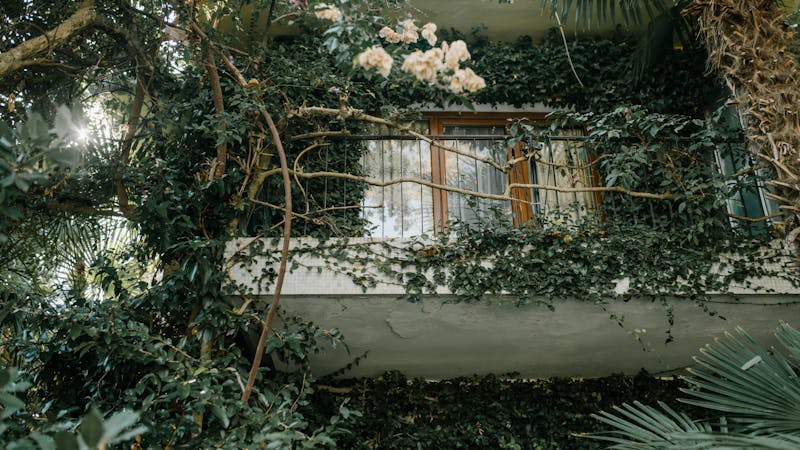
Balcony gardens are a great way to bring nature closer to your home, even if you have limited space. Whether you live in an apartment, condo, or home with a small outdoor area, creating a balcony garden can transform your limited space into a lush oasis.
Not only do they add beauty, but balcony gardens also help improve air quality, reduce stress, and create a peaceful retreat amidst urban life.
H1: Introduction to Balcony Gardens
H2: The appeal of balcony gardens
H2: Benefits of having a balcony garden
H1: Planning Your Balcony Garden
H2: Assessing one’s place
o H3: Measurement of available area
o H3: Understanding exposure to sunlight
H2: Choosing the right plants for balcony gardens
o H3: Plant selection based on climate
o H3: Low-maintenance plant varieties for busy people
H1: Maximum space in your garden
H2: Vertical gardening solutions
o H3: Wall Mounted Planter
o H3: Hanging baskets for small spaces
H2: Container gardening
o H3: Best Types of Containers for Balcony Gardens
o H3: Layering of containers for visual interest
H2: Use of railings and window boxes
o H3: How to secure planters to balcony railings.
o H3: Window boxes for herbs and flowers
H1: Design Ideas for Balcony Gardens
H2: Creating a comfortable seating area
o H3: Compact furniture options
o H3: Adding outdoor cushions and carpets
H2: Incorporating water features for comfort
o H3: Small fountains and water bowls.
o H3: DIY water features for small spaces
H1: Eco-friendly tips for balcony gardens
H2: Irrigation techniques to conserve water
o H3: Drip irrigation system
o H3: Use of recycled water
H2: Organic fertilizers and pest control
o H3: Household manure for fertilization
o H3: Natural remedies for pests
H1: Seasonal care for balcony gardens
H2: Protection of plants during winter
o H3: Insulation of vessels and containers
o H3: Moving plants indoors
• H2: Refreshing your garden for spring
o H3: Replanting seasonal flowers
o H3: Adding fresh soil and mulch
H1: Conclusion
H2: Embrace the joy of gardening
FAQs
Balcony Gardens: Maximizing Greenery in Limited Space Balcony gardens are a great way to bring nature closer to your living space, even when you don’t have a large yard. In urban environments where outdoor space is often limited, balconies offer a unique opportunity to create a personal green retreat.
With thoughtful planning, you can transform even the smallest garden into a thriving garden that offers an abundance of color, fragrance, and tranquility. From growing vibrant flowers to growing fresh herbs and vegetables, balcony gardens allow you to make the most of your limited space while reconnecting with nature.
Introduction to Balcony Gardens
 For city dwellers or anyone with limited outdoor space, balcony gardens offer a wonderful way to engage with nature. A balcony garden can be as simple or elaborate as you like, with options ranging from a few potted plants to a well-designed green space using vertical planters, hanging baskets, and container gardening.
For city dwellers or anyone with limited outdoor space, balcony gardens offer a wonderful way to engage with nature. A balcony garden can be as simple or elaborate as you like, with options ranging from a few potted plants to a well-designed green space using vertical planters, hanging baskets, and container gardening.
Whether you’re an experienced gardener or just starting, gardens give you the flexibility to experiment with different plants, textures, and colors within the confines of a small area. In addition, they offer a quiet escape from the hustle and bustle of city life, making your balcony a place of relaxation
The appeal of balcony gardens In the fast-paced world of urban life, it can be difficult to find ways to stay connected to nature. One of the most popular solutions is balcony gardening, a creative and efficient way to make the most of limited outdoor spaces. Balcony gardens provide a personal green retreat that not only enhances the aesthetics of your home,
but also helps create a sense of calm and relaxation. Whether you’re a seasoned gardener or a complete beginner, gardens offer something for everyone.
Benefits of having a balcony garden
Having a balcony garden is more than just adding plants to your space. It has numerous advantages, such as:
• Improving air quality by filtering pollutants.
• Creating space for rest and mental well-being.
• Encouraging pollinators such as bees and butterflies to visit your plants.
• Providing fresh herbs, fruits, and vegetables for your kitchen.
Assess your location
Before you start planting, it’s important to assess the space you’re working with. The size, shape, and exposure to sunlight on your balcony will all affect what you can grow and how you can arrange your garden.
Consider factors such as wind exposure and proximity to neighboring buildings, which can create a shady or microclimate affecting plant growth. With a clear understanding of your balcony conditions, you can plan a layout that maximizes the potential of your space.
Measurement of available area
Measure your balcony to get an accurate idea of how much space you have. This will help you choose the right containers, furniture, and accessories. Be sure to consider both floor area and vertical space – walls, railings, and even ceiling space can be used.
Understanding Sunlight Exposure
Sunlight is an important factor for plant growth. Note how much sunlight your balcony receives throughout the day. South-facing balconies receive the most sunlight, while north-facing balconies are more shaded. Choose plants that match the amount of light your balcony receives.
Choosing the Right Plants for Balcony Gardens One of the most exciting parts of balcony gardening is choosing your plants. Depending on the climate and conditions of your balcony, you can choose flowers, herbs, vegetables, or even small trees.
Flowers can bring vibrant color, herbs add fresh flavors to your cooking, and vegetables like tomatoes and peppers can provide homegrown produce. For those with plenty of room, dwarf trees or small shrubs can add height and texture to your balcony garden
Selection of plants based on climate
Your local climate will determine which plants will thrive. In warmer climates, succulent and Mediterranean herbs such as rosemary and thyme are excellent choices. For cooler climates, you can grow hardy perennials that can withstand temperature fluctuations.
Low-maintenance plant varieties for busy people
Low-maintenance plants like succulents, cacti, and air plants can make your balcony garden beautiful and easy to maintain if you have a busy lifestyle.
These hardy plants are also great for beginners, as they are extremely flexible and adaptable to different conditions. Their sculptural shapes and textures can give your balcony a stylish and modern look without requiring constant attention
Maximize space in your Garden
Vertical gardening solutions
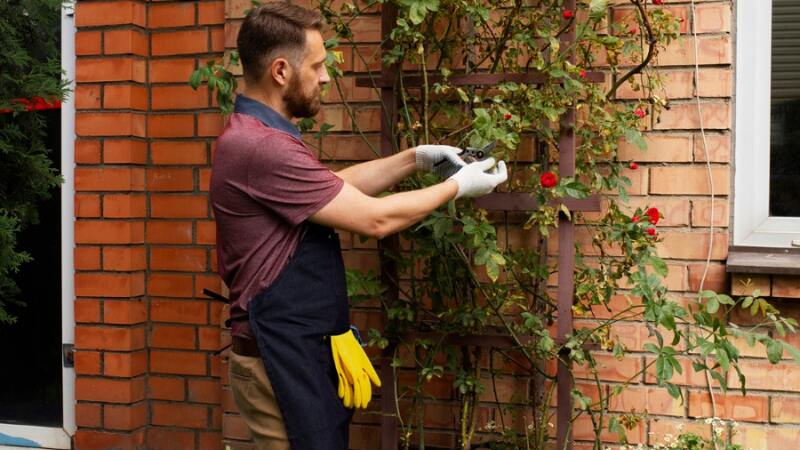
Vertical gardening is one of the best ways to maximize limited space. By growing upwards rather than outwards, you can have more plants without cluttering your balcony.
This method not only maximizes your space but also adds layers and depth to your garden design. Whether using hanging planters, shelves, or trellises, vertical gardening allows you to experiment with different plant combinations and create a dynamic visual effect.
Wall Mounted Planter: Grow flowers, herbs, or even tiny veggies in pots that are fixed on the wall They save space and add a lush, green backdrop to your balcony.
They also add vertical interest to your space, serving as a natural backdrop that brings life and energy to your balcony. With wall-mounted planters, you can easily create a mini-garden that’s both functional and visually striking
Hanging baskets for small spaces
Hanging baskets are perfect for trailing plants such as ferns, ivy, or strawberries. They can be hung from the ceiling or attached to a railing to free up floor space.

Besides saving space, hanging baskets create a cascading effect that adds beauty and dimension to your garden. By growing plants high, you can enjoy lush greenery at eye level, which adds a stunning focal point to your balcony garden
Container gardening
Containers are essential for balcony gardens. The right containers can make your garden feel bigger and more organized.

Containers also provide flexibility, allowing you to rearrange or move plants based on sunlight or aesthetic preferences. With containers, you can grow a variety of plants, including flowers, herbs and small vegetables, making them a versatile option for any balcony space
Best Types of Containers for Gardens
Choose lightweight containers that can be moved around easily, especially if you have a small balcony. Terracotta, plastic, and fiberglass containers are great options. Make sure they have good drainage holes to avoid waterlogging.
Additionally, consider using self-watering containers, which are perfect for those who may forget to water regularly. Choosing UV-resistant materials will also help your containers withstand harsh outdoor conditions, increasing their longevity
Layering containers for visual interest Containers of different heights can be layered to add visual interest and depth.
Tall containers can be placed in the back, with smaller containers in front for an organized yet lush look By combining different textures, colors, and sizes, you can create an eye-catching display that maximizes the use of limited space.
This layered arrangement not only enhances the aesthetics but also ensures that each plant gets the right amount of sunlight
Use of railings and window boxes
Railings and window boxes are great for growing small plants, and they free up floor space for larger plants or furniture.
These boxes can be used to grow herbs, trailing flowers, or even compact vegetables, creating an attractive and functional feature on your balcony edge. Window boxes and railings help frame the space, providing a cohesive look while also making maintenance and pruning of smaller plants easier
How to Secure Planters to a Balcony Railing
Use sturdy brackets to secure your planters to the railing. Make sure they are properly fastened to avoid accidents during windy conditions.
Make sure the brackets are rust-resistant and designed for outdoor use to withstand the elements. Additionally, consider using adjustable railing planters, which offer more flexibility in placement and are easier to install safely
Window boxes for herbs and flowers
Window boxes are ideal for growing herbs, small flowers, or even lettuce and spinach. They add charm to your balcony while making good use of space.
These bins are perfect for adding a green touch without cluttering the floor, allowing easy access to your fresh herbs right from your kitchen. With proper drainage and sunlight, window boxes can support a variety of compact, fast-growing plants
Creating a comfortable seating area
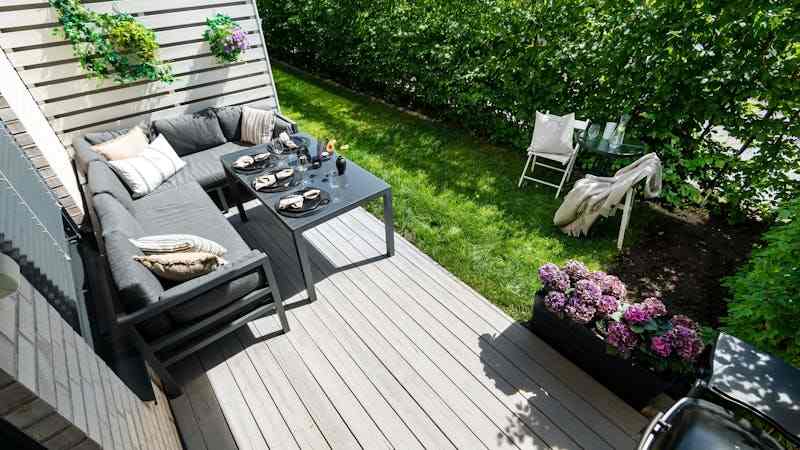 A balcony garden should be a space you can enjoy, so it’s important to include a seating area.
A balcony garden should be a space you can enjoy, so it’s important to include a seating area.
Even in a small space, creating a cozy corner for relaxation can turn your balcony into a personal retreat. Choose seating that is easy to maintain and complements the aesthetics of your garden, making the space feel inviting and functional.
Compact furniture options
Look for compact furniture like folding chairs and small tables that won’t overwhelm the space. You can also consider multifunctional pieces, such as benches with built-in storage.
Folding furniture can be easily removed when not in use, while storage benches provide a great solution for neatly hiding gardening tools or cushions. Choose materials that are durable and weather-resistant so they can last outside
Adding outdoor cushions and rugs
Adding outdoor cushions and rugs can make your balcony more comfortable and visually appealing. Select textiles that are resilient to weather conditions.
Weather-resistant fabrics, such as those treated with UV protection and water-repellent finishes, ensure that your textiles remain vibrant and functional all year round. Rugs help define the seating area and add warmth, creating a cozy, homey atmosphere outdoors
Adding water features for relaxation
Water features add a sense of calm to any space, and they don’t have to be big or expensive to make an impact. The gentle sound of running water creates a calming atmosphere, helping you to relax and escape from the hustle and bustle of city life.
Whether you want to add a small fountain or a simple water bowl, the presence of water can elevate the peaceful atmosphere of your balcony garden
Small fountains and water bowls.
Small tabletop fountains or water bowls with floating candles can bring a peaceful atmosphere to your balcony garden. These compact features are ideal for small spaces and can be placed on desks or corners without taking up too much space.
Besides their calming effect, water bowls with floating candles or flowers can add a decorative and romantic touch to your garden
DIY water features for small spaces
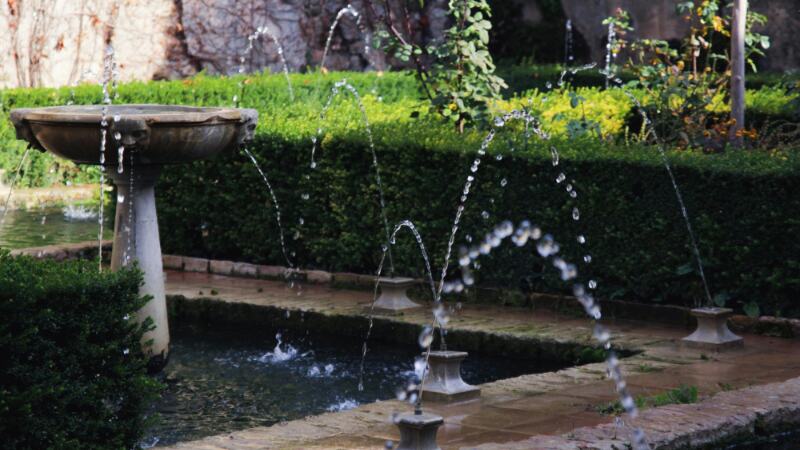
You can easily make a DIY water feature using a pot, a small pump, and some decorative stones. This is a simple yet effective way to introduce the calming sound of water into your space.
DIY water features allow you to customize the design to fit your garden theme, and they’re often more budget-friendly than store-bought alternatives. You can get creative with different containers and even add plants like water lilies to enhance the aesthet
Watering techniques to conserve water Conserving water is important, especially in small gardens where overwatering can easily occur. Implementing eco-friendly practices, such as reusing rainwater or using organic compost, can help reduce your environmental impact.
Sustainable gardening techniques not only conserve resources but also promote healthy plants and a greener planet.
Drip irrigation system
 To get water straight to your plants’ roots, install a drip irrigation system. This reduces water wastage and ensures your plants get the hydration they need. Drip irrigation systems are highly efficient and can be easily adapted to a small garden.
To get water straight to your plants’ roots, install a drip irrigation system. This reduces water wastage and ensures your plants get the hydration they need. Drip irrigation systems are highly efficient and can be easily adapted to a small garden.
They deliver water slowly and directly to the soil, preventing runoff and evaporation, making them a great choice for environmentally conscious gardeners
Use of recycled water
Collect rainwater or use leftover water from washing vegetables to water your plants. This eco-friendly method reduces water usage and provides your plants with a natural source of moisture.
Using recycled water not only saves water but also helps your plants benefit from nutrients leached from vegetables. Placing a rain barrel on your balcony or collecting water in containers is an easy way to make your gardening more sustainable.
Home compost for fertilization
Making your compost from kitchen scraps is a great way to provide organic nutrients to your plants. Composting reduces waste and turns everyday items like fruit peels, coffee grounds, and egg shells into nutritious food for your garden.
Slow decomposition of organic matter creates a balanced compost that enriches the soil, promotes healthy plant growth, and improves soil structure. Plus, it’s a cost-effective and eco-friendly way to nurture your plants.
Natural Remedies for Pests Avoid using harmful chemicals by turning to natural pest control methods. Neem oil, soap sprays, and companion planting are effective ways to keep your garden pest-free. Companion planting involves growing certain plants together to repel pests, such as marigolds to deter aphids.
Similarly, neem oil disrupts the life cycle of many insects without harming beneficial insects. Soap sprays work by suffocating small insects, offering a gentle but effective solution to keeping plants healthy.
Protection of plants during winter
If you live in an area with winters, you’ll need to protect your plants from the elements. Severe winter weather, including frost and freezing temperatures, can damage or kill sensitive plants.
Use protective structures such as cool clothing or bring potted plants indoors to protect against the cold. Mulching around the base of plants also helps protect the roots, ensuring they stay warm during the colder months.
Insulation of vessels and containers
Wrap your pots with bubble wrap or burlap to keep the roots warm during the colder months. You can also move plants closer to walls where they will be more sheltered from the wind.
Insulation helps prevent the roots from freezing, which can be especially important for perennials.
Another option is to use insulated pots or double pots for your plants to create an extra layer of warmth. A little preparation can protect your plants from winter damage.
Moving plants indoors
For delicate plants, consider bringing them indoors during the winter. Place them near windows where they can still get natural light.
Make sure they are placed in a well-lit area but away from direct heat sources such as radiators, which can dry out the air. Indoor plants may need less water during the winter months, so be careful not to overwater. Keeping these plants inside until the weather warms up ensures they survive harsh winter conditions
Freshening up your garden for spring
Spring is the perfect time to freshen up your balcony garden and prepare it for the growing season. Start by clearing away any dead leaves and debris that may have accumulated over the winter to make room for new growth.
This is a great time to trim back overgrown plants and refresh your garden layout with new plants and accessories.With the right care, your balcony will bloom beautifully, welcoming the new season with vibrant greenery.
Replanting seasonal flowers
Swap winter plants for fresh, seasonal flowers like tulips, daffodils, and pansies. These colorful flowers will give your garden a new look for the warmer months. Choose species that thrive in your area and provide a burst of color to liven up your space.
Seasonal flowers not only beautify your garden but also attract beneficial pollinators like bees and butterflies, which further enrich your garden ecosystem.
Adding fresh soil and mulch
Bring your garden to life by adding fresh soil and mulch. This provides your plants with new nutrients and helps retain moisture as the weather warms. Fresh soil ensures that your plants have a nutrient-rich base for growth,
while mulch acts as a barrier that protects the soil from erosion and prevents weeds. Mulching keeps the soil cool even on hot days and reduces the need for frequent watering.
Conclusion
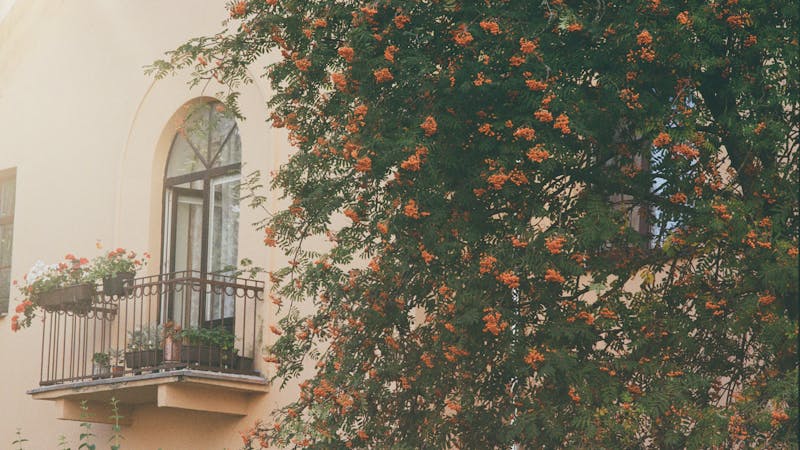
Balcony gardens offer a unique opportunity to maximize greenery even in small spaces. By carefully planning your space, choosing the right plants, and using creative design solutions, you can turn your balcony into a thriving garden.
Whether you want to grow herbs, and flowers, or just create a relaxing outdoor space, gardening allows you to enjoy the benefits of nature right at home. It’s not just about aesthetics; gardens can also improve air quality, reduce stress, and provide a sanctuary from urban life.
With the right care, even the smallest plant can flourish year-round, offering beauty and sustainability. Additionally, balcony gardens contribute to a greener environment, promoting biodiversity and eco-friendly living practices.
FAQs
1. What are the best plants for a sunny balcony?
Plants like succulents, lavender, and tomatoes thrive in full sunlight, making them perfect for sunny balconies.
2. Can I grow vegetables on my balcony?
Oh yes! You can grow a variety of vegetables like tomatoes, lettuce, peppers, and herbs on your balcony.
3. How can I prevent my balcony garden from becoming overcrowded?
Use vertical gardening techniques like wall plants and hanging baskets to maximize space without cluttering the floor.
4. How often should I water my balcony plants?
It depends on the plants and weather conditions, but in general, check the soil moisture and water when the top inch feels dry.
5. Do balcony gardens attract insects?
Yes, but many of these insects, such as bees and butterflies, are beneficial pollinators. To keep insects at bay, use natural repellants like neem oil.


